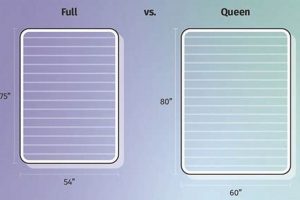The dimensions of a standard full mattress are typically 54 inches wide and 75 inches long. This size offers more sleeping space than a twin mattress, making it a suitable choice for single adults who desire extra room to stretch out or for guest rooms where couples may occasionally stay. These dimensions represent the industry standard, though minor variations of an inch or so may occur depending on the manufacturer.
Understanding mattress sizes is crucial for selecting bedding, ensuring the proper fit of sheets, comforters, and bed frames. Historically, this particular mattress size gained popularity as housing units became larger, accommodating furniture that occupied a greater footprint. The additional width compared to smaller mattresses contributes to enhanced comfort and a more restful sleep experience for many individuals. It bridges the gap between the compact twin and larger queen options.
The subsequent sections will delve deeper into comparing full mattress dimensions with other common mattress sizes, exploring factors to consider when choosing the right mattress for individual needs, and providing guidance on selecting appropriate bedding and frames to complement a full-sized sleeping surface.
Tips Regarding Full Mattress Dimensions
The following advice addresses considerations when evaluating whether standard full mattress dimensions are suitable for specific needs. Accurate understanding of size is crucial.
Tip 1: Before purchasing a full mattress, measure the intended bedroom space. Ensure sufficient room for the bed itself, plus adequate clearance for movement and other furniture. A cramped room diminishes the benefit of a larger sleeping surface.
Tip 2: Assess the number of sleepers who will regularly use the mattress. While suitable for a single adult, full mattress dimensions may prove inadequate for couples seeking comfortable, uninterrupted sleep. Queen or King sizes offer greater individual space.
Tip 3: Evaluate body size and sleeping habits. Taller individuals, or those who frequently toss and turn, may find full mattress dimensions restrictive. Consider the increased length and width of a Queen or King for unrestricted movement.
Tip 4: Confirm compatibility with existing or planned bed frames. Standard full mattress dimensions require a corresponding full-size bed frame. Verify dimensions before purchase to avoid incompatibility issues.
Tip 5: Scrutinize bedding dimensions. Full-size sheets, comforters, and blankets are designed to fit standard full mattress dimensions. Ensuring accurate measurements when purchasing bedding prevents ill-fitting and uncomfortable arrangements.
Tip 6: Account for potential future needs. If circumstances may change, such as adding a partner, consider purchasing a larger mattress initially. This prevents the need for future replacement due to inadequate sleeping space.
Tip 7: Consider the weight capacity. Different mattress types and construction materials possess varying weight limits. Ensure the selected full mattress can adequately support the intended weight of the sleeper(s) for optimal longevity and support.
These tips offer guidance for evaluating the suitability of standard full mattress dimensions. Careful consideration of individual needs and circumstances ensures a more comfortable and practical sleeping arrangement.
The subsequent section will address commonly asked questions regarding full-size mattress dimensions and related purchasing considerations.
1. Width
The measurement of 54 inches in width is a defining characteristic of a standard full size mattress. This dimension directly dictates the amount of lateral space available to a sleeper, influencing comfort, movement, and overall suitability for individuals or couples.
- Individual Sleeper Comfort
The 54-inch width provides a balance between compactness and spaciousness for a single adult. It allows for comfortable movement throughout the night without being excessively large for smaller rooms. For example, a single sleeper who enjoys ample space to stretch out may find this width preferable to a narrower twin mattress, but without requiring the significantly larger footprint of a queen. Individuals taller than average should also consider if this width is suitable for their frame.
- Suitability for Couples
While a full size mattress can accommodate two adults, the 54-inch width provides only 27 inches of space per person. This restricted space can lead to disrupted sleep if one partner is restless or has a larger frame. The 54-inch width is generally less than what couples prefer; couples should look into queen or king beds for more comfort, uninterrupted sleep, and ample breathing room.
- Room Size Considerations
The width is a crucial factor when determining whether a full size mattress fits comfortably within a bedroom. A 54-inch wide mattress requires a room that can accommodate its dimensions, along with additional space for movement around the bed and other furniture. Smaller bedrooms may feel cramped with a full size mattress, negatively impacting the room’s usability and comfort.
- Bedding and Frame Compatibility
The standardized 54-inch width is the benchmark for full-size bedding and bed frames. Ensuring compatibility between the mattress width and the corresponding bedding and frame sizes is essential for a proper fit and optimal functionality. Standard full-size sheets, comforters, and frames are designed specifically to accommodate this width. Deviation from this standard may lead to ill-fitting bedding or structural instability.
The 54-inch width of a standard full size mattress is inextricably linked to its overall utility and suitability for various sleepers and room configurations. Careful consideration of this dimension, in relation to individual needs and spatial constraints, is vital for selecting the appropriate mattress size. Failing to account for how width plays a role in sleeping can affect sleep quality, movement, and frame compatibility.
2. Length
The 75-inch length constitutes a critical dimension of a standard full size mattress, influencing its suitability for individuals of varying heights. This measurement defines the longitudinal sleeping surface, determining whether a sleeper can comfortably extend their body without encountering the mattress’s edge. The 75-inch length is a standardized value; deviations from this measurement impact compatibility with full-size bed frames and bedding. As an example, an individual measuring approximately six feet tall (72 inches) may find a 75-inch mattress marginally adequate, but a more extended option, such as a queen or king, could provide improved comfort and prevent potential foot overhang.
The relationship between mattress length and sleeper height is not merely about physical accommodation; it also affects sleep quality. Insufficient length can force a sleeper to adopt a curled or bent posture, potentially leading to muscle strain, discomfort, and disrupted sleep patterns. Furthermore, the 75-inch standard length plays a central role in manufacturing, ensuring consistent sizing for production efficiency and simplifying the consumer’s choice when selecting compatible accessories. Bed frame manufacturers design their full-size frames to accommodate this specific length, and bedding companies produce sheets and comforters with dimensions tailored to fit. This standardization simplifies the process of outfitting a full size mattress.
In summary, the 75-inch length is an indispensable component of the dimensional profile of a standard full size mattress. Its primary role is accommodating the height of the sleeper, and its standardized nature promotes compatibility across related products. Considering sleeper height is essential when evaluating the suitability of a full-size mattress. The correlation of the length to bed-frame and beddings also increases efficiency in mattress purchasing for customers, in contrast to irregular bed sizes and beddings.
3. Area
The calculated surface area of 4050 square inches represents a key metric for understanding the dimensions and practical space offered by a standard full size mattress. This figure, derived from multiplying the width (54 inches) by the length (75 inches), provides a quantitative measure for comparing its size to other mattress options and evaluating its suitability for specific needs.
- Comparative Space Assessment
The 4050 square inch area allows for direct comparison with the surface areas of other mattress sizes. For example, a twin mattress (approximately 39 inches x 75 inches) has an area of 2925 square inches, illustrating that a full size mattress offers a significant increase in sleeping space. Similarly, a queen mattress (approximately 60 inches x 80 inches) yields an area of 4800 square inches, indicating it provides even more room. This comparative measure assists consumers in making informed decisions based on spatial requirements. This area comparison is crucial for individuals transitioning from smaller beds and wanting to know the space they will gain.
- Impact on Sleeper Comfort
The total area directly relates to the comfort level experienced by the sleeper(s). A larger area generally translates to increased freedom of movement and reduced risk of disturbing a partner. In the context of a full size mattress, the 4050 square inch area may prove adequate for a single sleeper seeking extra room, but potentially restrictive for couples seeking ample personal space. If the 4050 sq in area is too small, sleep quality diminishes.
- Bedding Selection Criteria
The 4050 square inch area informs the selection of appropriate bedding. While standard “full size” sheets and comforters are designed to fit mattresses with these dimensions, variations in thickness or design (e.g., deep-pocket sheets) may require adjustments. Understanding the area, in conjunction with mattress height, ensures that bedding drapes correctly and provides adequate coverage. When blankets and sheets are undersized for the surface, comfort is compromised and there is an increased risk of slippage.
- Relationship to Room Size
The area occupied by a full size mattress is a critical factor in determining its suitability for a given room. A mattress with a surface area of 4050 square inches requires sufficient surrounding space for comfortable movement and furniture placement. Overcrowding a room with an oversized mattress compromises the room’s functionality and aesthetic appeal. Homeowners should consider room dimensions before mattress size.
In conclusion, the calculated area of 4050 square inches provides a valuable reference point for understanding the dimensions and practical implications of a standard full size mattress. This metric, when considered alongside individual needs and spatial constraints, facilitates informed decision-making and optimizes comfort and functionality. Careful consideration of the area in relation to comfort makes the selection process easier and more valuable to end-users.
4. Frame Compatibility
Frame compatibility is inextricably linked to the standardized dimensions of a full-size mattress. Deviation from these standard dimensions (54 inches wide and 75 inches long) can lead to significant issues when attempting to pair the mattress with a corresponding bed frame. Strict adherence to dimensional standards by manufacturers ensures proper fit and optimal support.
- Structural Integrity and Support
A bed frame designed for a full-size mattress provides specific support points and weight distribution calibrated to the mattress’s dimensions. When a mattress is undersized or oversized relative to the frame, structural integrity is compromised. This can lead to sagging, uneven support, and premature wear of both the mattress and the frame. For instance, if a mattress is even an inch or two smaller than the frame, the gap can cause the mattress to shift, decreasing support and comfort.
- Bedding Fit and Aesthetics
While the frame primarily provides structural support, it also influences the overall aesthetic of the bed. A properly fitting mattress ensures that bedding drapes correctly and the bed maintains its intended appearance. An ill-fitting mattress can create unsightly gaps or overhangs, detracting from the bed’s visual appeal. It may also require alterations to bedding to compensate for the size discrepancy.
- Safety Considerations
Incompatibility between a mattress and frame can pose safety hazards. An unstable mattress can shift unexpectedly, potentially leading to falls or injuries, especially for children or the elderly. Securely fitting a mattress within its frame minimizes the risk of movement and provides a stable sleeping surface. The right frame provides edge support, preventing roll-off.
- Longevity and Warranty Implications
Using a mattress with an incompatible frame can void manufacturer warranties. Many mattress warranties stipulate the use of a properly sized and supportive frame. Damage resulting from using an unsuitable frame may not be covered under warranty, resulting in unexpected expenses. Consistent and proper usage, alongside a compatible frame, ensures the full life of the mattress.
The preceding facets illustrate the critical importance of frame compatibility in relation to the dimensions of a full-size mattress. Deviations can compromise structural integrity, aesthetics, safety, and warranty coverage. Selecting a frame specifically designed for a full-size mattress ensures optimal support, safety, and longevity. Therefore, manufacturers precise adherence to what a full size mattress should measure directly contributes to compatibility.
5. Height Variation
Height variation in mattresses, while not a fixed component of what defines the length and width measurements of a full-size mattress, significantly impacts overall bed profile, comfort, and the selection of appropriate bedding. The height of a mattress, often referred to as its thickness, can range considerably, influencing factors from ease of getting in and out of bed to the fit of sheets.
- Impact on Bed Profile and Accessibility
Mattress height affects the overall height of the bed, which influences accessibility. A thicker mattress on a standard bed frame can result in a higher sleeping surface, potentially posing challenges for individuals with mobility issues. Conversely, a thinner mattress may make the bed too low. Selecting a mattress height that aligns with individual needs ensures ease of access and optimal comfort. It is essential to measure both the mattress and bed frame height before selecting sheets.
- Influence on Sheet Fit and Bedding Selection
Mattress height directly determines the type of sheets required. Standard sheets are designed for mattresses of average thickness, while deeper-pocket sheets are necessary for thicker mattresses. Using standard sheets on a thick mattress may result in the sheets slipping off, while using deep-pocket sheets on a thinner mattress can lead to a loose and untidy fit. Therefore, considering height variation is crucial when purchasing bedding. The right sheets promote comfort and prevent damage to the fabric.
- Considerations for Bed Frame Design
The height of a mattress can also influence the choice of bed frame. Some bed frames, particularly those with headboards and footboards, are designed to accommodate specific mattress heights. A mattress that is too short may leave a significant gap between the mattress and headboard, while a mattress that is too tall may obscure the headboard. Selecting a mattress height that complements the bed frame design ensures a cohesive and aesthetically pleasing look. Incompatibility can compromise the visual appeal of the room.
- Effect on Support and Comfort Layers
Height variation often corresponds to differences in the number and thickness of support and comfort layers within the mattress. Thicker mattresses typically feature more substantial support cores and thicker comfort layers, potentially offering enhanced support and pressure relief. However, a thicker mattress does not automatically guarantee superior comfort; the quality of the materials and construction also play a significant role. Thicker is not always better when evaluating comfort.
In conclusion, while height variation does not alter the standard length and width measurements of a full-size mattress, it is a crucial factor to consider when evaluating overall bed comfort, accessibility, and aesthetics. Careful consideration of mattress height, in relation to individual needs and preferences, ensures a more satisfactory and functional sleep environment. Therefore, height variations have implications for what a full size mattress constitutes in terms of usability.
Frequently Asked Questions
This section addresses common queries regarding the dimensions of a standard full mattress, providing clarity on its size and implications.
Question 1: What precisely are the standard dimensions of a full-size mattress?
A standard full-size mattress measures 54 inches in width and 75 inches in length.
Question 2: Can slight variations in dimensions be expected?
Minor variations, typically within an inch, may exist due to manufacturing tolerances. Significant deviations should be cause for concern.
Question 3: How does the sleeping area of a full mattress compare to that of a queen mattress?
A queen mattress provides a larger sleeping area. A standard queen is usually 60 inches wide by 80 inches long, in contrast to a full mattress at 54 x 75 inches.
Question 4: Is a full-size mattress adequate for two adults?
While a full mattress can accommodate two adults, the reduced width (27 inches per person) may lead to compromised comfort and potential sleep disturbance. Queen or King size mattresses are preferable for couples.
Question 5: What type of bed frame is required for a full-size mattress?
A bed frame specifically designed for a full-size mattress is required. This ensures proper support and prevents potential damage to the mattress. Confirm interior frame dimensions prior to purchase.
Question 6: What size bedding should be purchased for a full-size mattress?
Bedding labeled as “full size” or “double” is designed to fit a standard full mattress. Deep-pocket sheets may be necessary for thicker mattresses.
Understanding these dimensions and related considerations is crucial for making informed purchasing decisions and ensuring a comfortable sleep experience.
The subsequent section will offer a comprehensive buying guide, providing actionable advice for selecting the right full-size mattress based on individual needs and preferences.
What Measurement Is a Full Size Mattress
This exploration has rigorously defined the core dimensions of what measurement is a full size mattress, emphasizing its standard 54-inch width and 75-inch length. The analysis has addressed the implications of these measurements on sleeper comfort, compatibility with bed frames and bedding, and overall suitability for various individual needs and spatial constraints. Detailed scrutiny of related aspects, such as height variations and surface area calculations, further enriches the understanding of the full mattress category.
Accurate interpretation of mattress dimensions remains paramount for informed consumer choices. As bedroom sizes evolve and individual sleeping preferences diversify, careful consideration of these standardized measurements will facilitate selection of a sleep solution optimized for comfort, longevity, and value. The informed consumer is empowered to prioritize precision in mattress selection, ensuring a harmonious blend of form and function within the sleeping environment.







